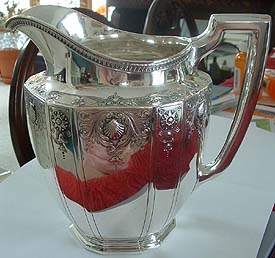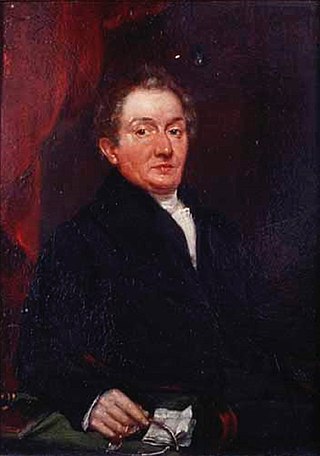
Paul Revere was an American silversmith, military officer and industrialist who played a major role during the opening months of the American Revolutionary War in Massachusetts, engaging in a midnight ride in 1775 to alert nearby minutemen of the approach of British troops prior to the battles of Lexington and Concord.

Sterling silver is an alloy composed by weight of 92.5% silver and 7.5% other metals, usually copper. The sterling silver standard has a minimum millesimal fineness of 925.

A silversmith is a metalworker who crafts objects from silver. The terms silversmith and goldsmith are not exact synonyms, as the techniques, training, history, and guilds are largely the same but differed in that the end product may vary greatly.

The American Civil War was the most widely covered conflict of the 19th century. The images would provide posterity with a comprehensive visual record of the war and its leading figures, and make a powerful impression on the populace. Something not generally known by the public is the fact that roughly 70% of the war's documentary photography was captured by the twin lenses of a stereo camera. The American Civil War was the first war in history whose intimate reality would be brought home to the public, not only in newspaper depictions, album cards and cartes-de-visite, but in a popular new 3D format called a "stereograph," "stereocard" or "stereoview." Millions of these cards were produced and purchased by a public eager to experience the nature of warfare in a whole new way.

Nathaniel Currier was an American lithographer. He headed the company Currier & Ives with James Ives.

Taft Stettinius & Hollister, commonly known as "Taft", is an American, AmLaw100 law firm founded in Cincinnati, with offices in Cleveland, Columbus, Dayton and Delaware, Ohio; Chicago, Illinois; Denver, Colorado; Detroit, Michigan; Indianapolis, Indiana; Covington, Kentucky; Minneapolis, Minnesota; Phoenix, Arizona; and Washington, DC. Taft has been referred to as Cincinnati's most prestigious law firm.

Garrard & Co. Limited, formerly Asprey & Garrard Limited, designs and manufactures luxury jewellery and silver. George Wickes founded Garrard in London in 1735 and the brand is headquartered at Albemarle Street in Mayfair, London. Garrard also has a presence in a number of other locations globally. Garrard was the first official and most notably important Crown Jeweller of the United Kingdom having supplied jewels for Queen Victoria, and was charged with the upkeep of the British Crown Jewels, from 1843 to 2007, and was responsible for the creation of many tiaras and jewels still worn by the British royal family today. As well as jewellery, Garrard is known for having created some of the world's most illustrious sporting trophies, including the America's Cup, the ICC Cricket World Cup Trophy and a number of trophies for Royal Ascot in its role as Official Trophies and Silverware Supplier, which originally dates back to the first Gold Cup in 1842.

Paul Storr was an English goldsmith and silversmith working in the Neoclassical and other styles during the late eighteenth and early nineteenth centuries. His works range from simple tableware to magnificent sculptural pieces made for royalty.
William Emes was an English landscape gardener.

The House of Bolin is one of the oldest firms specialising in jewellery and silverware that remains in the hands of its founding family. The firm exists today as Jewellers and Silversmiths to HM the King of Sweden.
Edward Barnard and Sons was a firm of British silversmiths. They created the Lily font, a large silver gilt baptismal font used in the christening services of members of the British Royal family.
R. Wallace & Sons was formed in Wallingford, Connecticut, and incorporated in 1879. As of 1893, this company manufactured silver and plated ware and cutlery and had about 600 employees.

George Wickes was an English silversmith who in 1735 founded the company that was to become Garrard & Co.
Margaret Binley or Bingley was an 18th-century English silversmith.
Sarah Buttall was an English silversmith.
Mary Chawner, néeBurwash, was an English silversmith.
Mary Troby was an English silversmith.

Edward Chandler Moore was an American silversmith, art collector, and benefactor of the Metropolitan Museum of Art.

Samuel Kirk was an American silversmith, active in Baltimore, Maryland, and best known for his introduction of repoussé to the United States. He engaged in various partnerships with his sons under the names of S. Kirk and Son and S. Kirk and Sons. In 1979 S. Kirk & Son was purchased by the Stieff Company, which renamed itself Kirk Stieff.

Reid & Sons is a firm of silversmiths founded in Newcastle upon Tyne in 1788 by Christian Ker Reid and which continues to trade today as part of the 'Goldsmiths Group'. In 2013 Reid & Sons celebrated its 235th anniversary. Over the years the various branches of the company have been known as Christian Ker Reid; Reid & Son; Reid & Sons; Reid & Sons Ltd; Craddock & Reid; William Ker Reid and Edward Ker Reid.














